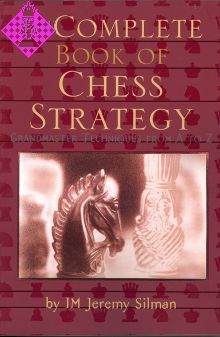Artikelnummer
LMSILTCBOCS
Autor
The Complete Book of Chess Strategy
Grandmaster Techniques from A to Z
360 Seiten, kartoniert, Siles Press, Erstauflage 1998
the complete book of chess strategy is an amateur's dream come true! Due to the overwhelming amount of strategic and tactical ideas in chess, students of the game buy dozens of chess books but still find it impossible to isolate the key points. Seeing the problems his students faced, Mr. Silman has created the first comprehensive strategic guide in dictionary form. Now all aspects of chess strategy, tactics, basic opening and endgame ideas, and even psychology are painlessly accessible to players of all degrees of strength. Each concept is listed alphabetically, accompanied by a clear, easy-to-absorb explanation and an example.
Studying has never been easier! Take this book to work, on vacation or, if you're a serious competitive player, to all your tournaments.' The world's best players make regular use of this information. With everything presented in simple, easy-to-understand language, Grandmaster techniques can finally become your technique too?
Introduction:
Years ago I heard a student lament that he wasn't able to read a chess book and digest its lessons in a proper way - he couldn't understand what the book was really trying to teach him.
I thought a lot about his complaint. It finally dawned on me that the vast majority of books are so filled with soulless rhetoric that it would take a genius to sift through the all the glittering rocks to find that one tiny bit of gold that may or may not be floating somewhere in its pages.
Positions and moves won't teach you much without carefully chosen words to fill in the gaps. Sadly, that's what most chess books are made of - positions and moves with little or no proper explanation.
One day I noticed another student diligently writing in a notebook. He explained that he would take the salient points of his studies and my lessons and write them down in a simple, easy to understand form. This way he could go to a tournament and review this material before his games. No digging was necessary, no hard work, just instant facts and strategies waiting at his fingertips.
This book is a more detailed version of that extremely practical notebook. All aspects of basic strategy and tactics are presented in a simple, easy to absorb manner. You look at the information you want to learn, it tells you what you need to know and gives you a quick illustration, and then you move on to the next fact.
I have presented the material in four parts: The Opening, The Middlegame, The Endgame, and Practical Matters. All the information in these sections is presented in alphabetical order so you can access it immediately.
Finally, I have added quizzes at the end of each section so you can test yourself and see if you really understood the material.
This book was written for players in the class "E" (pre-tournament or beginning tournament) through class "A" (experienced tournament) categories. It gives advice about chess psychology, tells you how to handle different types of structural problems, gives you the basics on all major openings, provides instruction for would be attackers, and...well, you name it, I've tried to address it!
My intention in writing this book is to help players who have nowhere else to turn, so let me know if I have succeeded in answering your questions. If I've overlooked some important subject, write to me (care of Siles Press) and I will add it to a future edition.
Jeremy Silman March 1998
Studying has never been easier! Take this book to work, on vacation or, if you're a serious competitive player, to all your tournaments.' The world's best players make regular use of this information. With everything presented in simple, easy-to-understand language, Grandmaster techniques can finally become your technique too?
Introduction:
Years ago I heard a student lament that he wasn't able to read a chess book and digest its lessons in a proper way - he couldn't understand what the book was really trying to teach him.
I thought a lot about his complaint. It finally dawned on me that the vast majority of books are so filled with soulless rhetoric that it would take a genius to sift through the all the glittering rocks to find that one tiny bit of gold that may or may not be floating somewhere in its pages.
Positions and moves won't teach you much without carefully chosen words to fill in the gaps. Sadly, that's what most chess books are made of - positions and moves with little or no proper explanation.
One day I noticed another student diligently writing in a notebook. He explained that he would take the salient points of his studies and my lessons and write them down in a simple, easy to understand form. This way he could go to a tournament and review this material before his games. No digging was necessary, no hard work, just instant facts and strategies waiting at his fingertips.
This book is a more detailed version of that extremely practical notebook. All aspects of basic strategy and tactics are presented in a simple, easy to absorb manner. You look at the information you want to learn, it tells you what you need to know and gives you a quick illustration, and then you move on to the next fact.
I have presented the material in four parts: The Opening, The Middlegame, The Endgame, and Practical Matters. All the information in these sections is presented in alphabetical order so you can access it immediately.
Finally, I have added quizzes at the end of each section so you can test yourself and see if you really understood the material.
This book was written for players in the class "E" (pre-tournament or beginning tournament) through class "A" (experienced tournament) categories. It gives advice about chess psychology, tells you how to handle different types of structural problems, gives you the basics on all major openings, provides instruction for would be attackers, and...well, you name it, I've tried to address it!
My intention in writing this book is to help players who have nowhere else to turn, so let me know if I have succeeded in answering your questions. If I've overlooked some important subject, write to me (care of Siles Press) and I will add it to a future edition.
Jeremy Silman March 1998
the complete book of chess strategy is an amateur's dream come true! Due to the overwhelming amount of strategic and tactical ideas in chess, students of the game buy dozens of chess books but still find it impossible to isolate the key points. Seeing the problems his students faced, Mr. Silman has created the first comprehensive strategic guide in dictionary form. Now all aspects of chess strategy, tactics, basic opening and endgame ideas, and even psychology are painlessly accessible to players of all degrees of strength. Each concept is listed alphabetically, accompanied by a clear, easy-to-absorb explanation and an example.
Studying has never been easier! Take this book to work, on vacation or, if you're a serious competitive player, to all your tournaments.' The world's best players make regular use of this information. With everything presented in simple, easy-to-understand language, Grandmaster techniques can finally become your technique too?
Introduction:
Years ago I heard a student lament that he wasn't able to read a chess book and digest its lessons in a proper way - he couldn't understand what the book was really trying to teach him.
I thought a lot about his complaint. It finally dawned on me that the vast majority of books are so filled with soulless rhetoric that it would take a genius to sift through the all the glittering rocks to find that one tiny bit of gold that may or may not be floating somewhere in its pages.
Positions and moves won't teach you much without carefully chosen words to fill in the gaps. Sadly, that's what most chess books are made of - positions and moves with little or no proper explanation.
One day I noticed another student diligently writing in a notebook. He explained that he would take the salient points of his studies and my lessons and write them down in a simple, easy to understand form. This way he could go to a tournament and review this material before his games. No digging was necessary, no hard work, just instant facts and strategies waiting at his fingertips.
This book is a more detailed version of that extremely practical notebook. All aspects of basic strategy and tactics are presented in a simple, easy to absorb manner. You look at the information you want to learn, it tells you what you need to know and gives you a quick illustration, and then you move on to the next fact.
I have presented the material in four parts: The Opening, The Middlegame, The Endgame, and Practical Matters. All the information in these sections is presented in alphabetical order so you can access it immediately.
Finally, I have added quizzes at the end of each section so you can test yourself and see if you really understood the material.
This book was written for players in the class "E" (pre-tournament or beginning tournament) through class "A" (experienced tournament) categories. It gives advice about chess psychology, tells you how to handle different types of structural problems, gives you the basics on all major openings, provides instruction for would be attackers, and...well, you name it, I've tried to address it!
My intention in writing this book is to help players who have nowhere else to turn, so let me know if I have succeeded in answering your questions. If I've overlooked some important subject, write to me (care of Siles Press) and I will add it to a future edition.
Jeremy Silman March 1998
Studying has never been easier! Take this book to work, on vacation or, if you're a serious competitive player, to all your tournaments.' The world's best players make regular use of this information. With everything presented in simple, easy-to-understand language, Grandmaster techniques can finally become your technique too?
Introduction:
Years ago I heard a student lament that he wasn't able to read a chess book and digest its lessons in a proper way - he couldn't understand what the book was really trying to teach him.
I thought a lot about his complaint. It finally dawned on me that the vast majority of books are so filled with soulless rhetoric that it would take a genius to sift through the all the glittering rocks to find that one tiny bit of gold that may or may not be floating somewhere in its pages.
Positions and moves won't teach you much without carefully chosen words to fill in the gaps. Sadly, that's what most chess books are made of - positions and moves with little or no proper explanation.
One day I noticed another student diligently writing in a notebook. He explained that he would take the salient points of his studies and my lessons and write them down in a simple, easy to understand form. This way he could go to a tournament and review this material before his games. No digging was necessary, no hard work, just instant facts and strategies waiting at his fingertips.
This book is a more detailed version of that extremely practical notebook. All aspects of basic strategy and tactics are presented in a simple, easy to absorb manner. You look at the information you want to learn, it tells you what you need to know and gives you a quick illustration, and then you move on to the next fact.
I have presented the material in four parts: The Opening, The Middlegame, The Endgame, and Practical Matters. All the information in these sections is presented in alphabetical order so you can access it immediately.
Finally, I have added quizzes at the end of each section so you can test yourself and see if you really understood the material.
This book was written for players in the class "E" (pre-tournament or beginning tournament) through class "A" (experienced tournament) categories. It gives advice about chess psychology, tells you how to handle different types of structural problems, gives you the basics on all major openings, provides instruction for would be attackers, and...well, you name it, I've tried to address it!
My intention in writing this book is to help players who have nowhere else to turn, so let me know if I have succeeded in answering your questions. If I've overlooked some important subject, write to me (care of Siles Press) and I will add it to a future edition.
Jeremy Silman March 1998
| EAN | 9781890085018 |
|---|---|
| Gewicht | 610 g |
| Hersteller | Siles Press |
| Breite | 15,2 cm |
| Höhe | 22,6 cm |
| Medium | Buch |
| Autor | Jeremy Silman |
| Sprache | Englisch |
| ISBN-10 | 1890085014 |
| ISBN-13 | 9781890085018 |
| Jahr der Erstauflage | 1998 |
| Seiten | 360 |
| Einband | kartoniert |
| Name | Siles Press |
|---|---|
| Adresse | Los Angeles Deutschland |
xv Introduction
xvii Symbol Legend
xix Chess Notation
001 PART ONE: THE OPENING
003 Basic Opening Strategy
004 Castling
005 Development
006 Financhetto
007 Opening Systems
101 Preparation
103 Reversed Openings
107 Opening Quizzes
109 PART TWO: THE MIDDLEGAME
111 Attack against the Enemy King
178 Blockade
181 Candidate moves and Imbalances
183 Centralization
184 Closed and Open Positions
188 Compensation
189 Counterplay
191 Defensive Strategy
192 Entombed Pieces
195 Initiative
197 Material Advantage
202 Minority Attack
206 Minor Pieces
220 Mysterious Rook Moves
222 Open Files
229 Overprotection
231 Pawn Center
233 Pawn Chain
235 Pawn Structure
255 Pawn Tension
257 Perpetual Check
259 Piece Activity
261 Plan
263 Principle of two weaknesses
265 Prophylaxis
267 Queenside Pawn Majority
270 Restriction
271 Space
272 Squares
273 Static versus dynamic advantages
276 Support points
279 Trading Pieces
280 Traps
281 Middlegame Quizzes
283 PART THREE: THE ENDGAME
285 Bishop and wrong rook pawn
287 Cat and mouse
292 Exchanging
295 Minor pieces in the endgame
297 Passed pawns in the endgame
302 Queen and minor piece fights
304 Stalemate
306 Using the king
317 Using the rooks
337 Endgame Quizzes
333 PART FOUR: PRACTICAL MATTERS
335 Blunder
338 Draw offer
340 Point count
343 Psychology
345 Time Pressure
347 Quizzes on Practical Matters
349 ANSWERS TO QUIZZES
xvii Symbol Legend
xix Chess Notation
001 PART ONE: THE OPENING
003 Basic Opening Strategy
004 Castling
005 Development
006 Financhetto
007 Opening Systems
101 Preparation
103 Reversed Openings
107 Opening Quizzes
109 PART TWO: THE MIDDLEGAME
111 Attack against the Enemy King
178 Blockade
181 Candidate moves and Imbalances
183 Centralization
184 Closed and Open Positions
188 Compensation
189 Counterplay
191 Defensive Strategy
192 Entombed Pieces
195 Initiative
197 Material Advantage
202 Minority Attack
206 Minor Pieces
220 Mysterious Rook Moves
222 Open Files
229 Overprotection
231 Pawn Center
233 Pawn Chain
235 Pawn Structure
255 Pawn Tension
257 Perpetual Check
259 Piece Activity
261 Plan
263 Principle of two weaknesses
265 Prophylaxis
267 Queenside Pawn Majority
270 Restriction
271 Space
272 Squares
273 Static versus dynamic advantages
276 Support points
279 Trading Pieces
280 Traps
281 Middlegame Quizzes
283 PART THREE: THE ENDGAME
285 Bishop and wrong rook pawn
287 Cat and mouse
292 Exchanging
295 Minor pieces in the endgame
297 Passed pawns in the endgame
302 Queen and minor piece fights
304 Stalemate
306 Using the king
317 Using the rooks
337 Endgame Quizzes
333 PART FOUR: PRACTICAL MATTERS
335 Blunder
338 Draw offer
340 Point count
343 Psychology
345 Time Pressure
347 Quizzes on Practical Matters
349 ANSWERS TO QUIZZES
Der US-amerikanische IM Jeremy Silman hat sich einen Namen gemacht durch den Gewinn etlicher Turniere, als Trainer der USA-Jugendnationalmannschaft und als Autor von nicht weniger als 36 (!!) Schachbüchern, vornehmlich Lehrbücher für aufstrebende junge Amateurspieler. In diese Kategorie fällt auch „Das vollständige Buch der Schach-Strategie". Hier umreißt Silman holzschnittartig kurz und damit zwangsläufig etwas oberflächlich (jeder Unterabschnitt der einzelnen Kapitel umfasst jeweils etwa eine bis sechs Buchseiten einschließlich der knapp kommentierten Beispiele) nahezu alle Gegebenheiten einer Schachpartie und den heutigen Wissensstand darüber. Am Ende jedes der vier Hauptabschnitte des Buches stellt er in Form eines „Quiz" einige Verständnisfragen (Teil 1: 20, Teil 2: 30, Teil 3 und 4: je 10), anhand derer der Lernende das Gelernte überprüfen kann. Die Lösungen finden sich im Anhang auf S. 349 bis 360.
Teil 1: Die Eröffnung (S. 1-108) befasst sich zunächst mit allgemeinen Eröffnungsgrundsätzen, mit der Wichtigkeit der Rochade und mit dem Fianchetto und listet sodann in alphabetischer Reihenfolge von Albins Gegengambit bis zur Veressow-Eröffnung insgesamt 45 mehr oder weniger gebräuchliche Spielanfänge auf mit knappen Hinweisen auf die Ziele beider Seiten im jeweiligen Eröffnungskampf. Damengambit und Sizilianisch z.B. werden auf je 6 Seiten abgehandelt, Spanisch nur auf 3 Seiten. Zum Abschluss folgen einige Gedanken über die Eröfnungsvorbereitung und über Eröffnungen mit vertauschten Farben.
Teil 2: Das Mittelspiel (S, 109-282): Im umfangreichsten Abschnitt wendet sich der Autor zunächst dem Königsangriff zu (heterogene Rochaden, klassisches Läuferopfer, Kombinationsthemen, Angriffe auf den König in der Mitte, Rochadeangriffe, Mattbilder, Opfer, taktische Voraussicht), um dann die Strategie zu beleuchten: Blockade, Kandidatenzüge, Zentralisierung, Kompensation und Gegenspiel. Defensivstrategie, gefangene Figuren, Initiative, Materialvorteil, Minoritätsangriff, Einsatz der Leichtfiguren, mysteriöse Turmzüge (Nimzowitsch lässt grüßen!), Offene Linien, Überdeckung (dito!), Bauernzentrum, Bauernketten, Bauernstrukturen, Freibauern, Doppelbauern, rückständige und hängende Bauern, Bauernspannung im Zentrum, Dauerschach, Figurenaktivität, Planfassung, Prinzip der zwei Schwächen, Bauernmehrheit am Damenflügel, Hemmung, Raumvorteil, statische versus dynamische Vorteile; „schwache Punkte", Figurentausch, Fallen.
Teil 3: Das Endspiel (S. 283-332): Dieses kommt etwas stiermütterlich weg -ganz im Gegensatz zu seiner großen praktischen Bedeutung! - mit den Themen: Läufer und falscher Randbauer, Lavieren, Abtausch, Leichtfiguren im Endspiel, Freibauern, Damen- und Leichtfiguren-Endspiele, Patt, Bauern- und Turmendspiele (elementares Wissen).
Teil 4: Tipps für die Praxis (S. 333-348): umfassen Betrachtungen über Fehler, Remis-Anbieten, schematisches Abzählen der Figuren-Wertpunkte, Psychologie und Zeitnot. Der Autor hat seine Zusammenschau aller Phasen der Schachpartie mit didaktischem Geschick und gut gewählten Beispielen (meistens Lehr-Stellungen, also nicht aus praktischen Partiestellungen entnommen) verfertigt. Sie kann „lernbegierigen Adepten" (um einen Terminus von Aaron Nimzowitsch zu gebrauchen, dessen Lehren aus seinem Klassiker „Mein System" hinlänglich in die Ausführungen im Teil 2 eingeflossen sind) mit entsprechenden Kenntnissen der englischen Sprache durchaus zur Fortbildung anempfohlen werden. Zur weiteren Vertiefung des Gelernten erscheint allerdings das Studium weiterführender Literatur unumgänglich -Beispiele hierfür werden vom Autor an mehreren Stellen seines Buches auch ganz konkret erwähnt.
Dr. W. Schweizer, Rochade Europa 09/2004
Teil 1: Die Eröffnung (S. 1-108) befasst sich zunächst mit allgemeinen Eröffnungsgrundsätzen, mit der Wichtigkeit der Rochade und mit dem Fianchetto und listet sodann in alphabetischer Reihenfolge von Albins Gegengambit bis zur Veressow-Eröffnung insgesamt 45 mehr oder weniger gebräuchliche Spielanfänge auf mit knappen Hinweisen auf die Ziele beider Seiten im jeweiligen Eröffnungskampf. Damengambit und Sizilianisch z.B. werden auf je 6 Seiten abgehandelt, Spanisch nur auf 3 Seiten. Zum Abschluss folgen einige Gedanken über die Eröfnungsvorbereitung und über Eröffnungen mit vertauschten Farben.
Teil 2: Das Mittelspiel (S, 109-282): Im umfangreichsten Abschnitt wendet sich der Autor zunächst dem Königsangriff zu (heterogene Rochaden, klassisches Läuferopfer, Kombinationsthemen, Angriffe auf den König in der Mitte, Rochadeangriffe, Mattbilder, Opfer, taktische Voraussicht), um dann die Strategie zu beleuchten: Blockade, Kandidatenzüge, Zentralisierung, Kompensation und Gegenspiel. Defensivstrategie, gefangene Figuren, Initiative, Materialvorteil, Minoritätsangriff, Einsatz der Leichtfiguren, mysteriöse Turmzüge (Nimzowitsch lässt grüßen!), Offene Linien, Überdeckung (dito!), Bauernzentrum, Bauernketten, Bauernstrukturen, Freibauern, Doppelbauern, rückständige und hängende Bauern, Bauernspannung im Zentrum, Dauerschach, Figurenaktivität, Planfassung, Prinzip der zwei Schwächen, Bauernmehrheit am Damenflügel, Hemmung, Raumvorteil, statische versus dynamische Vorteile; „schwache Punkte", Figurentausch, Fallen.
Teil 3: Das Endspiel (S. 283-332): Dieses kommt etwas stiermütterlich weg -ganz im Gegensatz zu seiner großen praktischen Bedeutung! - mit den Themen: Läufer und falscher Randbauer, Lavieren, Abtausch, Leichtfiguren im Endspiel, Freibauern, Damen- und Leichtfiguren-Endspiele, Patt, Bauern- und Turmendspiele (elementares Wissen).
Teil 4: Tipps für die Praxis (S. 333-348): umfassen Betrachtungen über Fehler, Remis-Anbieten, schematisches Abzählen der Figuren-Wertpunkte, Psychologie und Zeitnot. Der Autor hat seine Zusammenschau aller Phasen der Schachpartie mit didaktischem Geschick und gut gewählten Beispielen (meistens Lehr-Stellungen, also nicht aus praktischen Partiestellungen entnommen) verfertigt. Sie kann „lernbegierigen Adepten" (um einen Terminus von Aaron Nimzowitsch zu gebrauchen, dessen Lehren aus seinem Klassiker „Mein System" hinlänglich in die Ausführungen im Teil 2 eingeflossen sind) mit entsprechenden Kenntnissen der englischen Sprache durchaus zur Fortbildung anempfohlen werden. Zur weiteren Vertiefung des Gelernten erscheint allerdings das Studium weiterführender Literatur unumgänglich -Beispiele hierfür werden vom Autor an mehreren Stellen seines Buches auch ganz konkret erwähnt.
Dr. W. Schweizer, Rochade Europa 09/2004
Mehr von Siles Press
-
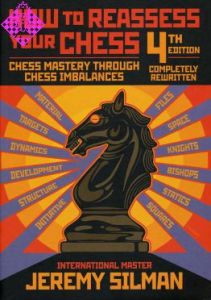 How to Reassess Your Chess35,95 €
How to Reassess Your Chess35,95 € -
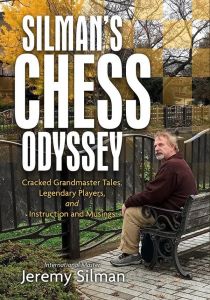 Silmans's Chess Odyssey9,95 € Regular Price 34,95 €
Silmans's Chess Odyssey9,95 € Regular Price 34,95 € -
 Bobby Fischer and His World19,95 € Regular Price 29,95 €
Bobby Fischer and His World19,95 € Regular Price 29,95 € -
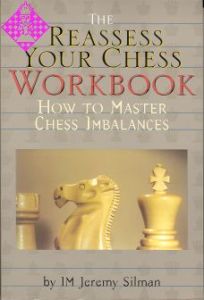 The Reassess Your Chess Workbook23,95 €
The Reassess Your Chess Workbook23,95 € -
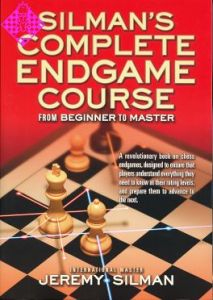 Silman's Complete Endgame Course29,95 €
Silman's Complete Endgame Course29,95 € -
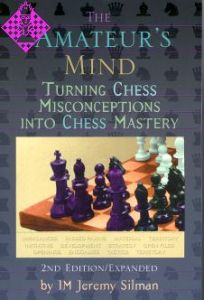 The Amateur's Mind24,95 €
The Amateur's Mind24,95 €

